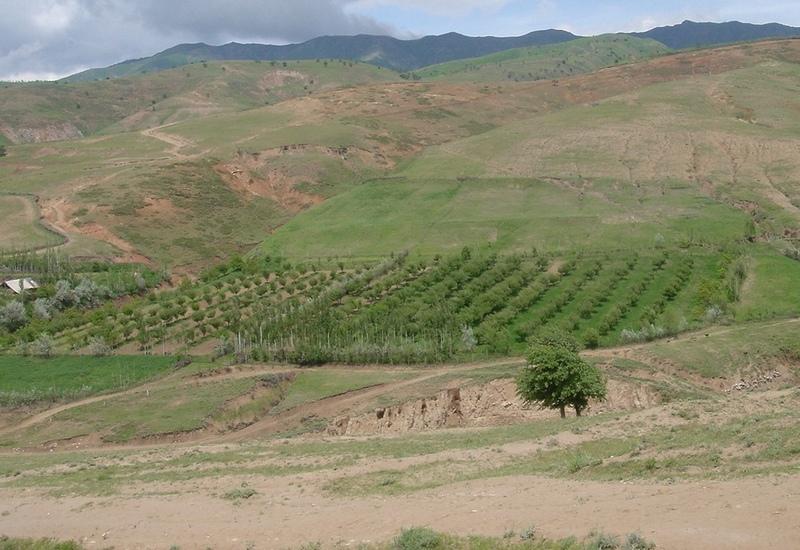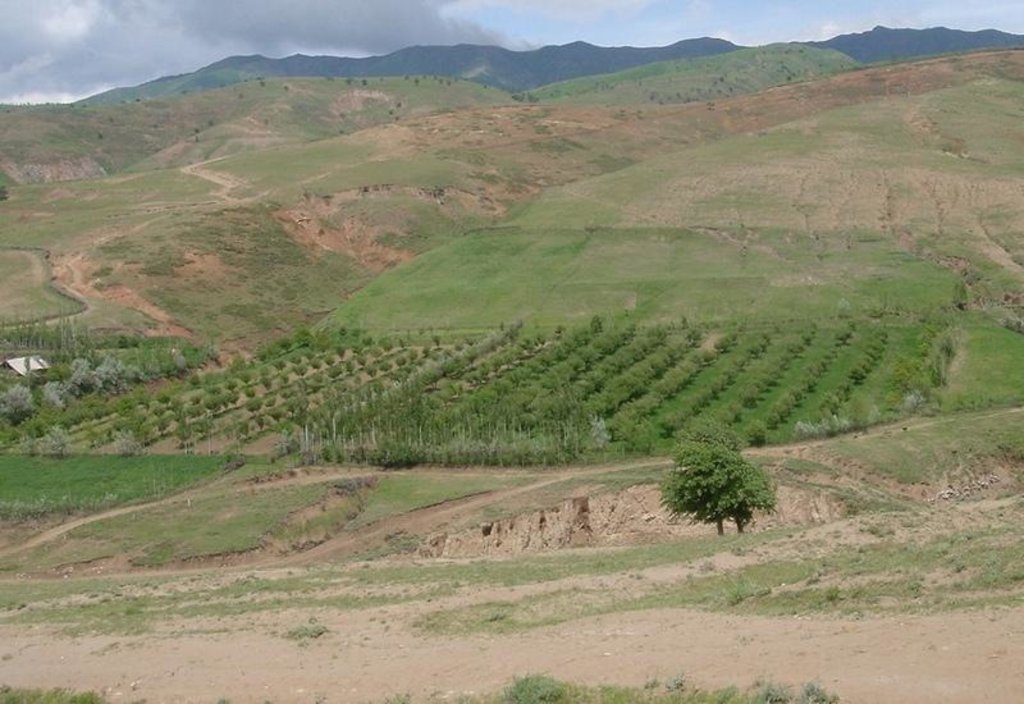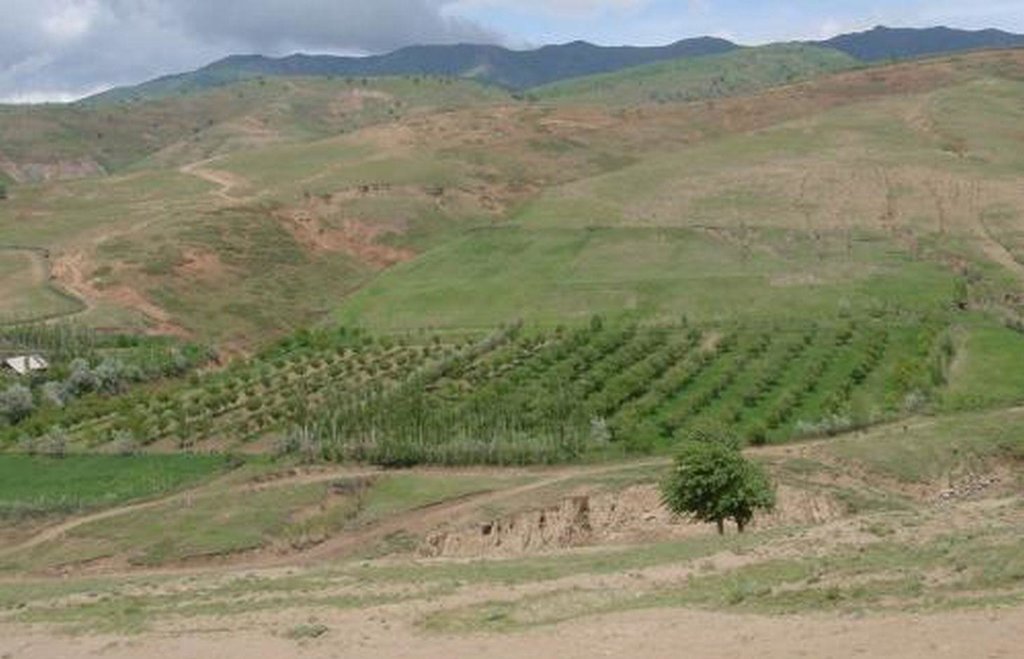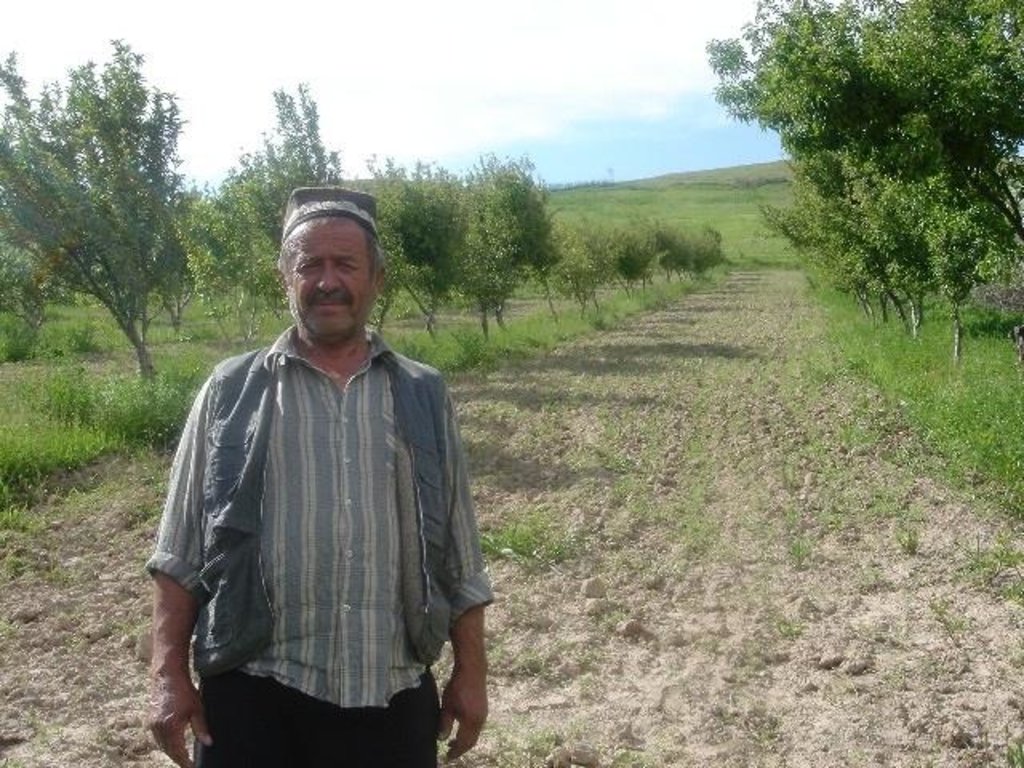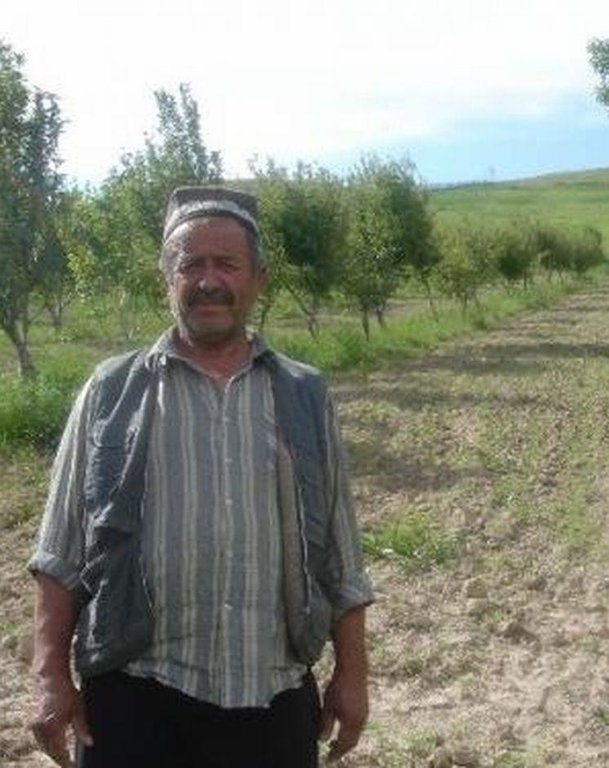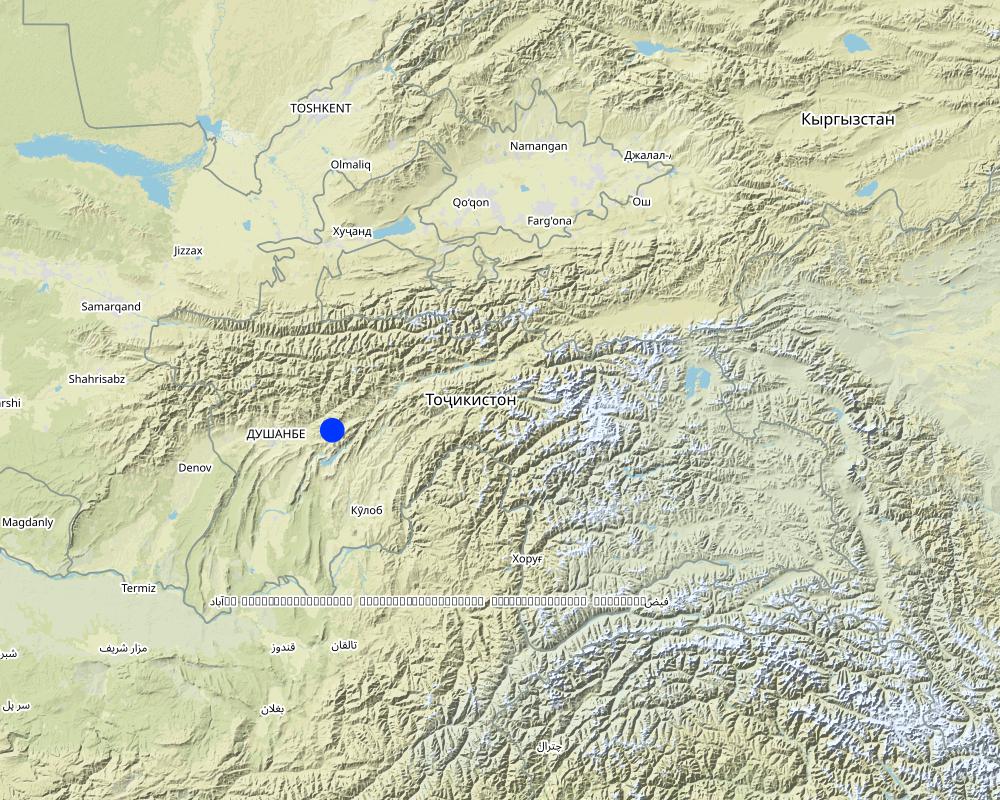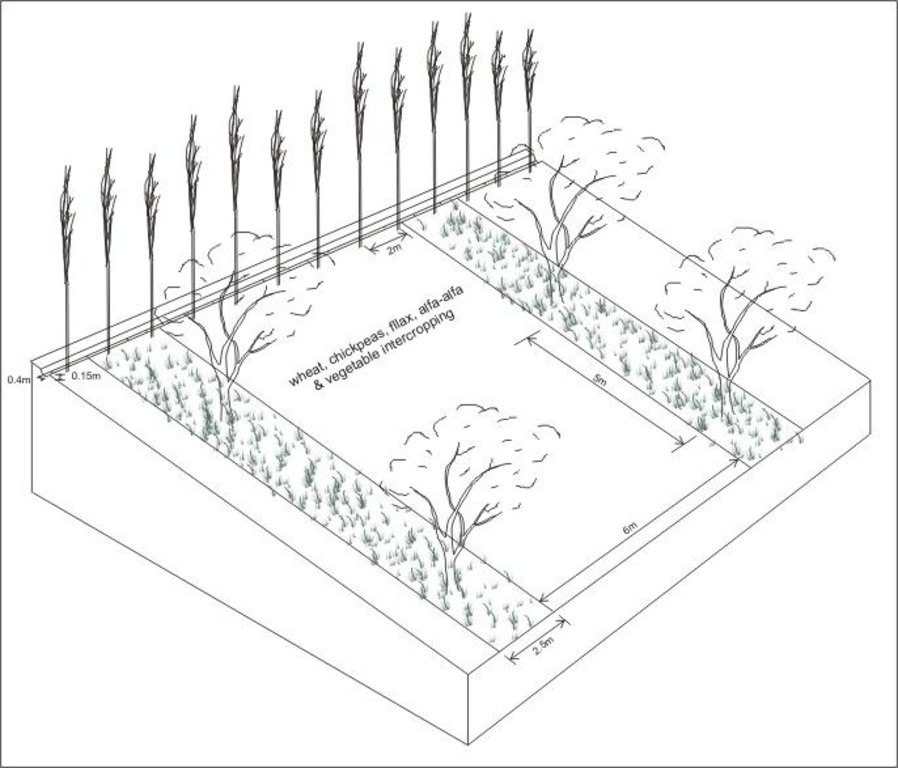Orchard-based Agroforestry (establishment of orchard) [ប្រទេសតាហ្ស៊ីគីស្ថាន]
- ការបង្កើត៖
- បច្ចុប្បន្នភាព
- អ្នកចងក្រង៖ Erik Bühlmann
- អ្នកកែសម្រួល៖ –
- អ្នកត្រួតពិនិត្យច្រើនទៀត៖ David Streiff, Alexandra Gavilano, Joana Eichenberger
technologies_1001 - ប្រទេសតាហ្ស៊ីគីស្ថាន
- សង្ខេបជា PDF
- សេចក្តីសង្ខេបពេញលេញជាទម្រង់ PDF សម្រាប់បោះពុម្ព
- សេចក្តីសង្ខេបពេញលេញទម្រង់អ៊ីនធឺនេត
- សេចក្តីសង្ខេបពេញលេញ (មិនមានទម្រង់ជាក់លាក់)
- Orchard-based Agroforestry (establishment of orchard): 20 ខែ សីហា ឆ្នាំ 2019 (inactive)
- Orchard-based Agroforestry (establishment of orchard): 2 ខែ វិច្ឆិកា ឆ្នាំ 2021 (public)
- Orchard-based Agroforestry (establishment of orchard): 19 ខែ កក្កដា ឆ្នាំ 2017 (inactive)
- Orchard-based Agroforestry (establishment of orchard): 17 ខែ កក្កដា ឆ្នាំ 2017 (inactive)
- Orchard-based Agroforestry (establishment of orchard): 10 ខែ មិនា ឆ្នាំ 2017 (inactive)
ពិនិត្យមើលគ្រប់ផ្នែក
ពង្រីកមើលទាំងអស់ បង្រួមទាំងអស់1. ព័ត៌មានទូទៅ
1.2 ព័ត៌មានលម្អិតពីបុគ្គលសំខាន់ៗ និងស្ថាប័នដែលចូលរួមក្នុងការវាយតម្លៃ និងចងក្រងឯកសារនៃបច្ចេកទេស
អ្នកជំនាញឯកទេស SLM:
ឈ្មោះគម្រោងដែលបានចងក្រងឯកសារ/ វាយតម្លៃលើបច្ចេកទេស (បើទាក់ទង)
Pilot Program for Climate Resilience, Tajikistan (WB / PPCR)ឈ្មោះអង្គភាពមួយ (ច្រើន) ដែលបានចងក្រងឯកសារ/ វាយតម្លៃបច្ចេកទេស (បើទាក់ទង)
CDE Centre for Development and Environment (CDE Centre for Development and Environment) - ប្រទេសស្វ៊ីសឈ្មោះអង្គភាពមួយ (ច្រើន) ដែលបានចងក្រងឯកសារ/ វាយតម្លៃបច្ចេកទេស (បើទាក់ទង)
NCCR North-South (NCCR North-South) - ប្រទេសកៀហ្ស៊ីស៊ីស្ថាន1.3 លក្ខខណ្ឌទាក់ទងទៅនឹងការប្រើប្រាស់ទិន្នន័យដែលបានចងក្រងតាមរយៈ វ៉ូខេត
អ្នកចងក្រង និង(បុគ្គលសំខាន់ៗ)យល់ព្រមទទួលយកនូវលក្ខខណ្ឌនានាទាក់ទងទៅនឹងការប្រើប្រាស់ទិន្នន័យដែលបានចងក្រងតាមរយៈវ៉ូខេត:
បាទ/ចា៎
1.5 ការយោងទៅលើកម្រងបញ្ជីសំណួរ (មួយ ឬច្រើន) នៃវិធីសាស្ត្រផ្សព្វផ្សាយ SLM (ដែលបានចងក្រងដោយទស្សនៈពិភពលោកស្តីពីវិធីសាស្ត្រ និងបច្ចេកទេសងអភិរក្ស WOCAT)

Voluntary Labour Assistance [ប្រទេសតាហ្ស៊ីគីស្ថាន]
Voluntary labour assistance for labour intensive activities whereby community members help each other in contributing labour on the basis of mutual understanding.
- អ្នកចងក្រង៖ Erik Bühlmann
2. ការពណ៌នាពីបច្ចេកទេស SLM
2.1 ការពណ៌នាដោយសង្ខេបពីបច្ចេកទេស
និយមន័យបច្ចេកទេស:
Establishment of an orchard intercropping system on severely degraded cropland.
2.2 ការពណ៌នាលម្អិតពីបច្ចេកទេស
ការពណ៌នា:
A fruit orchard (consisting of apples, apricots, cherries, pears and nut trees) was established on degraded cropland. Intercropping of annual crops such as wheat, flax, chick peas and vegetables as well as perennial herbaceous fodder plants (alfa-alfa and esparzet) were planted after the first year of the establishment of the orchard. Only the onion plot is rotated systematically since the farmer states that fertility declines due to heavy soil losses result from over-irrigation. Spacing of tree rows varies between 8-10m, the intercropping system is cultivated using a tractor. Fruit trees are aligned in the direction of the slope to facilitate irrigation. At the top of the field an irrigation channel (40cm wide, 15cm deep) stabilised with aligned poplar trees directs water onto the orchard system. During the rainy season the channel serves as a cut-off drain, protecting the land from water running on. Along the trees, a 2.5 m wide grass strip protects the ground from splash erosion.
Purpose of the Technology: The orchard system was established to increase farm production by integrating different resources, while simultaneously conserving soil and water resources and preventing development of gullies. Prior to tree planting, the area had been levelled with a bulldozer to restore the severely degraded cropland. The bought seedlings were planted in hand-dug pits. During summer, the orchard system is watered three days per week; manure is applied around the fruit trees on an annual basis. Pruning of the trees is done in early spring. Due to irrigation, the grass strips can be harvested twice a year for haymaking. Farming two crops at a time means gross farm production could be considerably increased, which is the reaon why the farmer considered the technology successful. However, establishment and maintenance of the technology is cost intensive and, in this case study, was only affordable due to the farmers off-farm income. Since the tree rows are aligned up and down the slope, soil erosion is solely reduced by the capability of the irrigation channel (and aligned tree barrier) to prevent the system from runon. Planting tree rows on the gradient would increase the technologies potential to reduce soil loss.
2.3 រូបភាពនៃបច្ចេកទេស
2.5 ប្រទេស/តំបន់/ទីតាំងកន្លែង ដែលបច្ចេកទេសត្រូវបានអនុវត្ត និងបានគ្រប់ដណ្តប់ដោយការវាយតម្លៃនេះ
ប្រទេស:
ប្រទេសតាហ្ស៊ីគីស្ថាន
តំបន់/រដ្ឋ/ខេត្ត:
RRS
បញ្ជាក់បន្ថែមពីលក្ខណៈនៃទីតាំង:
Faizabad Rayon
បញ្ជាក់ពីការសាយភាយនៃបច្ចេកទេស:
- ត្រូវបានផ្សព្វផ្សាយត្រឹមតំបន់មួយ
ប្រសិនបើមិនច្បាស់ពីទំហំផ្ទៃដី សូមធ្វើការប៉ាន់ប្រម៉ាណ:
- 0.1-1 គម2
Map
×2.7 ការណែនាំពីបច្ចេកទេស
សូមបញ្ជាក់តើបច្ចេកទេសត្រូវបានណែនាំឱ្យអនុវត្តដោយរបៀបណា:
- ពេលកំពុងពិសោធន៍
3. ចំណាត់ថ្នាក់នៃបច្ចេកទេស SLM
3.1 គោលបំណងចម្បង (១ ឬច្រើន) នៃបច្ចេកទេសនេះ
- កាត់បន្ថយ, បង្ការ, ស្តារឡើងវិញនូវការធ្លាក់ចុះគុណភាពដី
3.2 ប្រភេទដីប្រើប្រាស់មួយប្រភេទ (ច្រើនប្រភេទ) ដែលបានអនុវត្តបច្ចេកទេស
ដីប្រើប្រាស់ចម្រុះនៅលើដីតែមួយ:
បាទ/ចា៎
បញ្ជាក់ពីប្រភេទដីច្រើនប្រភេទ (ដីដាំដំណាំ/ដីចិញ្ចឹមសត្វ/ដីព្រៃឈើ):
- កសិរុក្ខកម្ម

ដីដាំដំណាំ
- ដំណាំប្រចាំឆ្នាំ
- ប្រភេទដើមឈើធំៗ និងដើមឈើតូចៗ
ដំណាំប្រចាំឆ្នាំ - បញ្ជាក់ប្រភេទដំណាំ:
- ពពួកសណ្តែក - គ្រាប់ហោឡាំងតាវ
- ដំណាំសរសៃ - ដើមកម្បាស ដើមក្រចៅ ផ្សេងៗ
- ធញ្ញជាតិ - ស្រូវសាលី (និទាឃរដូវ)
- ដំណាំចំណីសត្វ - alfalfa
- បន្លែ - ផ្សេងៗ
- esparzet
ប្រភេទដើមឈើធំៗ និងដើមឈើតូចៗ - បញ្ជាក់ប្រភេទ:
- ផ្លែឈើផ្សេងៗ
- stone fruits (ផ្លែប៉េស, apricot, ផ្លែឆឺរី, plum ។ល។)
- ដើមឈើយកគ្រាប់ (brazil nuts, pistachio, walnuts, almonds, etc.)
- ផ្លែប៉ោម (ប៉ោម សារី ។ល។)
ចំនួនសារដែលដាំដំណាំក្នុងមួយឆ្នាំ:
- 1
សូមបញ្ជាក់:
Longest growing period in days: 210Longest growing period from month to month: March - August
តើជាការអនុវត្តន៍ដំណាំចន្លោះ?
បាទ/ចា៎
ប្រសិនបើបាទ/ច៎ា សូមបញ្ជាក់ប្រភេទដំណាំដែលដាំចន្លោះគ្នានោះ:
Intercropping of annual crops such as wheat, flax, chick peas and vegetables as well as perennial herbaceous fodder plants (alfa-alfa and esparzet)

ដីសម្រាប់ចិញ្ចឹមសត្វ

ដីព្រៃ/ដីដាំដើមឈើ
មតិយោបល់:
Major land use problems (compiler’s opinion): Severe water erosion (gullies and rills) and subsequent decline in fertility on cropland and on overgrazed pastures.
Type of cropping system and major crops comments: If the land is irrigated, then after the harvest of annual crops (mid-July until beginning of August), and there is immediate sowing/planting of vegetables (maize, tomatoes, cucumbers, melon among others), then the harvest of vegetables in late August and September is possible.
3.4 ការផ្គត់ផ្គង់ទឹក
ការផ្គត់ផ្គង់ទឹកនៅកន្លែងអនុវត្តបច្ចេកទេស:
- ប្រព័ន្ធស្រោចស្រពទាំងស្រុង
មតិយោបល់:
Water supply also rainfed
3.5 ក្រុម SLM ដែលបច្ចេកទេសស្ថិតនៅក្នុង
- កសិរុក្ខកម្ម
3.6 វិធានការ SLM ដែលបញ្ចូលនូវបច្ចេកទេស

វិធានការក្សេត្រសាស្ត្រ
- A1: ដំណាំ/គម្របដី
- A2: សារធាតុសរីរាង្គ/ជីជាតិដី

វិធានការរុក្ខជាតិ
- V5: ផ្សេងៗ

វិធានការរចនាស័ម្ពន្ធ
- S11: ផ្សេងៗ

វិធានការគ្រប់គ្រង
- M1: ការផ្លាស់ប្តូរប្រភេទដីប្រើប្រាស់
មតិយោបល់:
Main measures: structural measures
Secondary measures: agronomic measures, vegetative measures
Type of agronomic measures: mixed cropping / intercropping, manure / compost / residues, mineral (inorganic) fertilizers
3.7 កំណត់ប្រភេទនៃការធ្លាក់ចុះគុណភាពដីសំខាន់ៗដែលបច្ចេកទេសនេះបានដោះស្រាយ

ការហូរច្រោះដីដោយសារទឹក
- Wt: ការបាត់ដីស្រទាប់លើដោយការហូរច្រោះ
- Wg: ការកកើតឡើងនូវកំទេចកំទីដីស្រទាប់ក្រោម

ការធ្លាក់ចុះសារធាតុគីមីក្នុងដី
- Cn: ការថយចុះជីជាតិ និងកាត់បន្ថយបរិមាណសារធាតុសរីរាង្គ (មិនកើតឡើងដោយការហូរច្រោះទេ)
មតិយោបល់:
Main type of degradation addressed: Wg: gully erosion / gullying
Secondary types of degradation addressed: Wt: loss of topsoil / surface erosion, Cn: fertility decline and reduced organic matter content
3.8 ការពារ កាត់បន្ថយ ឬស្តារឡើងវិញនៃការធ្លាក់ចុះគុណភាពដី
បញ្ជាក់ពីគោលដៅរបស់បច្ចេកទេស ដែលផ្តោតទៅការធ្លាក់ចុះគុណភាពដី:
- ការការពារការធ្លាក់ចុះគុណភាពដី
- ការកាត់បន្ថយការធ្លាក់ចុះគុណភាពដី
មតិយោបល់:
Main goals: prevention of land degradation
Secondary goals: mitigation / reduction of land degradation
4. បច្ចេកទេសជាក់លាក់ សកម្មភាពអនុវត្ត ធាតុចូល និងថ្លៃដើម
4.1 គំនូសបច្ចេកទេសនៃបច្ចេកទេសនេះ
លក្ខណៈពិសេសនៃបច្ចេកទេស (ទាក់ទងនឺងគំនូរបច្ចេកទេស):
Irrigated orchard system with intercropping; irrigation channel (stabilised by aligned poplar trees) also acts as a cut-off drain to prevent runon.
Location: Chinoro. Faizabad Rayon, RRS
Date: 18.07.2005
Technical knowledge required for field staff / advisors: moderate
Technical knowledge required for land users: moderate
Main technical functions: control of concentrated runoff: drain / divert, improvement of ground cover, stabilisation of soil (eg by tree roots against land slides)
Secondary technical functions: control of raindrop splash, increase in organic matter, increase in nutrient availability (supply, recycling,…), increase / maintain water stored in soil, increase in soil fertility
Mixed cropping / intercropping
Material/ species: wheat, chickpeas, flax, vegetables, alfa-alfa, esparzet
Remarks: between tree rows
Manure / compost / residues
Material/ species: manure
Quantity/ density: 20kg/tree
Remarks: spreading around fruit trees
Mineral (inorganic) fertilizers
Material/ species: silitra and/or superphosphate
Quantity/ density: 200kg/ha
Remarks: only if wheat is intercropped
Vegetative measure: aligned: slope direction
Vegetative material: F : fruit trees / shrubs
Number of plants per (ha): 200
Spacing between rows / strips / blocks (m): 8
Vertical interval within rows / strips / blocks (m): 5
Vegetative measure: aligned: slope direction
Vegetative material: F : fruit trees / shrubs
Spacing between rows / strips / blocks (m): 8
Width within rows / strips / blocks (m): 2
Vegetative measure: aligned: along irigation channel on contour
Vegetative material: F : fruit trees / shrubs
Number of plants per (ha): 50
Vertical interval within rows / strips / blocks (m): 2
Vegetative measure: Vegetative material: F : fruit trees / shrubs
Trees/ shrubs species: poplar trees
Fruit trees / shrubs species: apple, pear, cherry, apricot, peach and nut trees
Grass species: grass cover with esparzet and alfa alfa (sown to improve grass cover)
Slope (which determines the spacing indicated above): 17.00%
Structural measure: diversion ditch / cut-off drain
Depth of ditches/pits/dams (m): 0.15
Width of ditches/pits/dams (m): 0.4
Length of ditches/pits/dams (m): 100
Construction material (earth): earth was moved to fill gullies and large rills
Slope (which determines the spacing indicated above): 17%
Vegetation is used for stabilisation of structures.
ឈ្មោះអ្នកនិពន្ធ:
Erik Bühlmann, Berne, Switzerland
4.2 ព័ត៌មានទូទៅដែលពាក់ព័ន្ធនឹងការគណនាធាតុចូល និងថ្លៃដើម
កំណត់រូបិយប័ណ្ណសម្រាប់ថ្លៃដើម:
- ដុល្លារ
កំណត់ថ្លៃឈ្នួលជាមធ្យមនៃការជួលកម្លាំងពលកម្មក្នុងមួយថ្ងៃ:
3.00
4.3 សកម្មភាពបង្កើត
| សកម្មភាព | រយៈពេល (រដូវកាល) | |
|---|---|---|
| 1. | land levelling and filling up of gullies | winter/early spring |
| 2. | digging of irrigation channel | spring |
| 3. | acquiring tree seedlings on market or at sovkhoze | |
| 4. | digging of pits | early spring |
| 5. | planting seedlings in pits | early spring |
| 6. | sowing of esparzet and alfa alfa (grass strips) to get intact grass cover | spring |
4.4 ថ្លៃដើម និងធាតុចូលដែលត្រូវការសម្រាប់ការបង្កើតបច្ចេកទេស
| បញ្ជាក់ពីធាតុចូល | ឯកតា | បរិមាណ | ថ្លៃដើមក្នុងមួយឯកតា | ថ្លៃធាតុចូលសរុប | % នៃថ្លៃដើមដែលចំណាយដោយអ្នកប្រើប្រាស់ដី | |
|---|---|---|---|---|---|---|
| កម្លាំងពលកម្ម | land levelling | ha | 1,0 | 45,0 | 45,0 | 100,0 |
| សម្ភារៈ | tools | ha | 1,0 | 25,0 | 25,0 | 100,0 |
| សម្ភារៈ | machine for land levelling | ha | 1,0 | 150,0 | 150,0 | |
| សម្ភារៈដាំដុះ | seedlings | ha | 1,0 | 250,0 | 250,0 | 100,0 |
| ថ្លៃដើមសរុបក្នុងការបង្កើតបច្ចេកទេស | 470,0 | |||||
| ថ្លៃដើមសរុបក្នុងការបង្កើតបច្ចេកទេសគិតជាដុល្លារ | 470,0 | |||||
4.5 សកម្មភាពថែទាំ
| សកម្មភាព | ពេលវេលា/ ភាពញឹកញាប់ | |
|---|---|---|
| 1. | clearing of irigation channel/cut-off drain from washed in soil | rainy season/weekly |
| 2. | periodical irrigation (3x a week) | summer /three days/week |
| 3. | periodical irrigation (3x a week) | summer /three days/week |
| 4. | application of manure | early spring /annual |
| 5. | application of manure | early spring /annual |
| 6. | application of pesticides | spring /annual |
| 7. | application of pesticides | spring /annual |
| 8. | pruning of fruit trees | winter/early spring /annual |
| 9. | pruning of fruit trees | winter/early spring /annual |
| 10. | cutting of grass (haymaking) | summer /twice a cropping season |
| 11. | cutting of grass (haymaking) | summer /twice a cropping season |
| 12. | ploughing of area between tree rows (disc plough) | depending on crop / annual |
| 13. | applying of mineral fertilisers | spring / annual (only for intercropped wheat) |
| 14. | weeding | spring / regularly |
| 15. | applying manure around fruit trees | winter/spring /annual |
4.6 កំណត់ថ្លៃដើមសម្រាប់ការថែទាំ/ សកម្មភាពរបស់បច្ចេកទេស (ក្នុងរយៈពេលមួយឆ្នាំ)
| បញ្ជាក់ពីធាតុចូល | ឯកតា | បរិមាណ | ថ្លៃដើមក្នុងមួយឯកតា | ថ្លៃធាតុចូលសរុប | % នៃថ្លៃដើមដែលចំណាយដោយអ្នកប្រើប្រាស់ដី | |
|---|---|---|---|---|---|---|
| កម្លាំងពលកម្ម | ploughing of area | ha | 1,0 | 20,0 | 20,0 | 100,0 |
| កម្លាំងពលកម្ម | sowing and weeding | ha | 1,0 | 18,0 | 18,0 | |
| កម្លាំងពលកម្ម | pruning of fruit trees | ha | 1,0 | 30,0 | 30,0 | |
| កម្លាំងពលកម្ម | spraying trees with biocides | ha | 1,0 | 12,0 | 12,0 | |
| សម្ភារៈដាំដុះ | seeds | ha | 1,0 | 30,0 | 30,0 | 100,0 |
| សម្ភារៈដាំដុះ | 1,0 | |||||
| ជី និងសារធាតុពុល | fertilizer | ha | 1,0 | 50,0 | 50,0 | 100,0 |
| ជី និងសារធាតុពុល | biocides | ha | 1,0 | 10,0 | 10,0 | 100,0 |
| ជី និងសារធាតុពុល | compost/manure | ha | 1,0 | 40,0 | 40,0 | 100,0 |
| ថ្លៃដើមសរុបសម្រាប់ការថែទាំដំណាំតាមបច្ចេកទេស | 210,0 | |||||
| ថ្លៃដើមសរុបសម្រាប់ការថែទាំដំណាំតាមបច្ចេកទេសគិតជាដុល្លារ | 210,0 | |||||
មតិយោបល់:
Costs were calculated for a 100x100 m field plot (with a projected 200 fruit trees/ha).
4.7 កត្តាសំខាន់បំផុតដែលមានឥទ្ធិពលដល់ការចំណាយ
ពណ៌នាពីកត្តាប៉ះពាល់ចម្បងៗទៅលើថ្លៃដើម:
Number of trees planted: since the establishment and maintainance require considerable financial and labour inputs; expenditures for tree seedlings bought from the market: N.B. if nursing the trees is completed by land user himself, establishment costs can be halved.
5. លក្ខណៈបរិស្ថានធម្មជាតិ និងមនុស្ស
5.1 អាកាសធាតុ
បរិមាណទឹកភ្លៀងប្រចាំឆ្នាំ
- < 250 មម
- 251-500 មម
- 501-750 មម
- 751-1,000 មម
- 1,001-1,500 មម
- 1,501-2,000 មម
- 2,001-3,000 មម
- 3,001-4,000 មម
- > 4,000 មម
តំបន់កសិអាកាសធាតុ
- មានភ្លៀងមធ្យម
growing period between 180-210 days
5.2 សណ្ឋានដី
ជម្រាលជាមធ្យម:
- រាបស្មើ (0-2%)
- ជម្រាលតិចតួច (3-5%)
- មធ្យម (6-10%)
- ជម្រាលខ្ពស់បន្តិច (11-15%)
- ទីទួល (16-30%)
- ទីទួលចោត (31-60%)
- ទីទួលចោតខ្លាំង (>60%)
ទម្រង់ដី:
- ខ្ពង់រាប
- កំពូលភ្នំ
- ជម្រាលភ្នំ
- ជម្រាលទួល
- ជម្រាលជើងភ្នំ
- បាតជ្រលងភ្នំ
តំបន់តាមរយៈកម្ពស់ :
- 0-100 ម
- 101-500 ម
- 501-1,000 ម
- 1,001-1,500 ម
- 1,501-2,000 ម
- 2,001-2,500 ម
- 2,501-3,000 ម
- 3,001-4,000 ម
- > 4,000 ម
5.3 ដី
ជម្រៅដីជាមធ្យម:
- រាក់ខ្លាំង (0-20 សម)
- រាក់ (21-50 សម)
- មធ្យម (51-80 សម)
- ជ្រៅ (81-120 សម)
- ជ្រៅខ្លាំង (> 120 សម)
វាយនភាពដី (ស្រទាប់លើ):
- មធ្យម (ល្បាយ, ល្បាប់)
សារធាតុសរីរាង្គនៅស្រទាប់ដីខាងលើ:
- ទាប (<1%)
បើអាចសូមភ្ជាប់ការពណ៌នាពីដីឱ្យបានច្បាស់ ឬព័ត៌មានដែលអាចទទួលបាន ឧ. ប្រភេទដី, pH ដី/ ជាតិអាស៊ីត, សមត្ថភាពផ្លាស់ប្តូរកាចុង, វត្តមាននីត្រូសែន, ភាពប្រៃ ។ល។:
Soil fertility: medium
Soil drainage / infiltration: medium
5.6 លក្ខណៈនៃអ្នកប្រើប្រាស់ដីដែលអនុវត្តបច្ចេកទេស
ទីផ្សារនៃប្រព័ន្ធផលិតកម្ម:
- សម្រាប់ហូបក្នុងគ្រួសារ (ផ្គត់ផ្គង់ខ្លួនឯង)
- ពាក់កណ្តាលពាណិជ្ជកម្ម (ផ្គត់ផ្គង់ខ្លួនឯង/ ពាណិជ្ជកម្ម)
ចំណូលក្រៅកសិកម្ម:
- ច្រើនជាង 50% នៃចំណូល
កម្រិតជីវភាព:
- មធ្យម
- មាន
កម្រិតប្រើប្រាស់គ្រឿងយន្ត:
- ប្រើកម្លាំងពលកម្ម
- គ្រឿងយន្ត/ ម៉ាស៊ីន
សូមបញ្ជាក់ពីលក្ខណៈពាក់ព័ន្ធផ្សេងទៀតអំពីអ្នកប្រើប្រាស់ដី:
5% of the land users are rich and own 15% of the land.
75% of the land users are average wealthy and own 70% of the land.
Off-farm income specification: In general, all farmers (including those applying SWC technologies) are highly dependent on off-farm incomes, which in most cases are earned in Russia, either by themselves or by their relatives.
Market orientation of production system subsistence (self-supply): Subsistence, only surpluses sold
Level of mechanization: Ploughing is carried out by tractor whenever possible, but also animal traction is existent.
5.7 ទំហំផ្ទៃដីជាមធ្យមនៃដីប្រើប្រាស់ដោយអ្នកប្រើប្រាស់ដី ក្នុងការអនុវត្តបច្ចេកទេស
- < 0.5 ហិកតា
- 0.5-1 ហិកតា
- 1-2 ហិកតា
- 2-5 ហិកតា
- 5-15 ហិកតា
- 15-50 ហិកតា
- 50-100 ហិកតា
- 100-500 ហិកតា
- 500-1,000 ហិកតា
- 1,000-10,000 ហិកតា
- > 10,000 ហិកតា
មតិយោបល់:
Households with 1-2 ha are depending on available working force, labour is limiting factor.
5.8 ភាពជាម្ចាស់ដី កម្មសិទ្ធប្រើប្រាស់ដី និងកម្មសិទ្ធប្រើប្រាស់ទឹក
ភាពជាម្ចាស់ដី:
- រដ្ឋ
កម្មសិទ្ធិប្រើប្រាស់ដី:
- កិច្ចសន្យាជួល
6. ផលប៉ះពាល់ និងការសន្និដ្ឋាន
6.1 ផលប៉ះពាល់ក្នុងបរិវេណអនុវត្តបច្ចេកទេសដែលកើតមាន
ផលប៉ះពាល់លើសេដ្ឋកិច្ចសង្គម
ផលិតផល
ផលិតកម្មដំណាំ
ផ្ទៃដីផលិតកម្ម
មតិយោបល់/ ការបញ្ជាក់:
loss of land for wheat production
ការគ្រប់គ្រងដី
មតិយោបល់/ ការបញ្ជាក់:
machines used for land cultivation cannot operate so easily
ចំណូល និងថ្លៃដើម
ចំណូលក្នុងកសិដ្ឋាន
ផលប៉ះពាល់ទៅលើសេដ្ឋកិច្ចសង្គមផ្សេងៗ
fruit yields
មតិយោបល់/ ការបញ្ជាក់:
due to lack of fertilisers and biocides
ផលប៉ះពាល់ទៅលើវប្បធម៌សង្គម
ចំណេះដឹង SLM / ការធ្លាក់ចុះគុណភាពដី
ការកាត់បន្ថយជម្លោះ
មតិយោបល់/ ការបញ្ជាក់:
disputes on land use rights with other villagers, since orchards are in great demand
ផលប៉ះពាល់ទៅលើអេកូឡូស៊ី
វដ្តទឹក/លំហូរ
ប្រព័ន្ធបង្ហូរទឹក
ដី
សំណើមដី
គម្របដី
ការបាត់បង់ដី
ការកាត់បន្ថយហានិភ័យនៃគ្រោះមហន្តរាយ និងគ្រោះអាកាសធាតុ
ល្បឿនខ្យល់
ផលប៉ះពាល់ទៅលើអេកូឡូស៊ីផ្សេងៗ
prevention of land from gullies and large rills
6.2 ផលប៉ះពាល់ក្រៅបរិវេណអនុវត្តបច្ចេកទេសដែលកើតមាន
ទឹកជំនន់ខ្សែទឹកខាងក្រោម
6.4 ការវិភាគថ្លៃដើម និងអត្ថប្រយោជន៍
តើផលចំណេញ និងថ្លៃដើមត្រូវបានប្រៀបធៀបគ្នាយ៉ាងដូចម្តេច (ទស្សនៈរបស់អ្នកប្រើប្រាស់ដី)?
រយៈពេលខ្លី:
ប៉ះពាល់តិចតួចបំផុត
រយៈពេលវែង:
វិជ្ជមានខ្លាំង
តើផលចំណេញ និងការថែទាំ/ ជួសជុលត្រូវបានប្រៀបធៀបគ្នាយ៉ាងដូចម្តេច (ទស្សនៈរបស់អ្នកប្រើប្រាស់ដី)?
រយៈពេលខ្លី:
វិជ្ជមាន
រយៈពេលវែង:
វិជ្ជមានខ្លាំង
6.5 ការទទួលយកបច្ចេកទេស
- > 50%
បើអាច សូមបញ្ជាក់ពីបរិមាណ (ចំនួនគ្រួសារ និង/ ឬតំបន់គ្របដណ្តប់):
20 households in an area of 0.1 - 1 km2
ក្នុងចំណោមគ្រួសារទាំងអស់ដែលបានអនុវត្តបច្ចេកទេស តើមានប៉ុន្មានគ្រួសារដែលចង់ធ្វើដោយខ្លួនឯង ដោយមិនទទួលបានសម្ភារៈលើកទឹកចិត្ត/ប្រាក់ឧបត្ថម្ភ?:
- 91-100%
មតិយោបល់:
100% of land user families have adopted the Technology without any external material support
20 land user families have adopted the Technology without any external material support
Comments on spontaneous adoption: estimates
There is a little trend towards spontaneous adoption of the Technology
6.7 ភាពខ្លាំង/ គុណសម្បត្តិ/ ឱកាសនៃបច្ចេកទេស
| ភាពខ្លាំង/ គុណសម្បត្តិ/ ឱកាសនៅកន្លែងរបស់អ្នកប្រើប្រាស់ដី |
|---|
| increase in overall farm income |
| prevention of gully and large rill erosion |
| ភាពខ្លាំង/ គុណសម្បត្តិ/ ឱកាស ទស្សនៈរបស់បុគ្គលសំខាន់ៗ |
|---|
| orchard system is protected from runon |
| effectively prevents formation of gullies and large rills |
| significant increases in gross farm production |
| effective way of rehabilitating bad lands |
|
increases soil fertility How can they be sustained / enhanced? consequent mulching would increase the organic matter content of the soil, and hence soil fertility |
6.8 ភាពខ្សោយ/ គុណវិបត្តិ/ ហានិភ័យនៃបច្ចេកទេស និងវិធីសាស្ត្រដោះស្រាយ
| ភាពខ្សោយ/ គុណវិបត្តិ/ ហានិភ័យ ទស្សនៈរបស់អ្នកប្រើប្រាស់ដី | តើបច្ចេកទេសទាំងនោះបានដោះស្រាយបញ្ហាដូចម្តេច? |
|---|---|
| fruit trees vulnerable to pests, frost and strong winds |
| ភាពខ្សោយ/ គុណវិបត្តិ/ ហានិភ័យ ទស្សនៈរបស់អ្នកចងក្រងឬបុគ្គលសំខាន់ៗ | តើបច្ចេកទេសទាំងនោះបានដោះស្រាយបញ្ហាដូចម្តេច? |
|---|---|
| high establishment and maintainance costs | if nursing of tree seedlings is carried out by the land user himself, establishment costs can be reduced |
| does not prevent soil erosion, soil losses especially where irrigated | By planting tree rows on gradient (not up and down the slope) |
| management of orchard systems requires considerable inputs which often cannot be afforded by poor people |
7. ឯកសារយោង និងវេបសាយ
7.1 វិធីសាស្ត្រ/ ប្រភពនៃព័ត៌មាន
ការតភ្ជាប់ និងម៉ូឌុល
ពង្រីកមើលទាំងអស់ បង្រួមទាំងអស់ការតភ្ជាប់

Voluntary Labour Assistance [ប្រទេសតាហ្ស៊ីគីស្ថាន]
Voluntary labour assistance for labour intensive activities whereby community members help each other in contributing labour on the basis of mutual understanding.
- អ្នកចងក្រង៖ Erik Bühlmann
ម៉ូឌុល
គ្មានម៉ូឌុល


